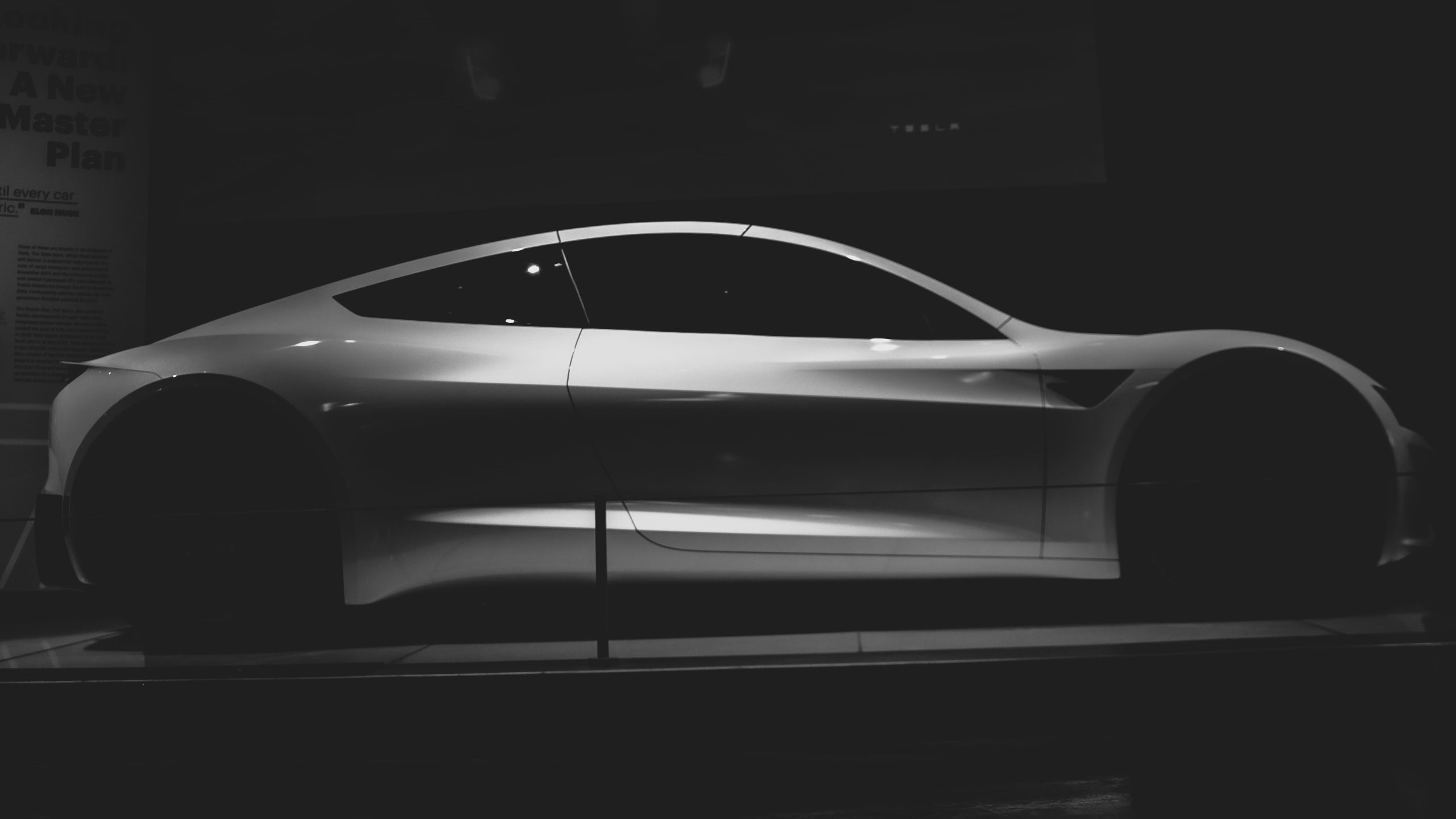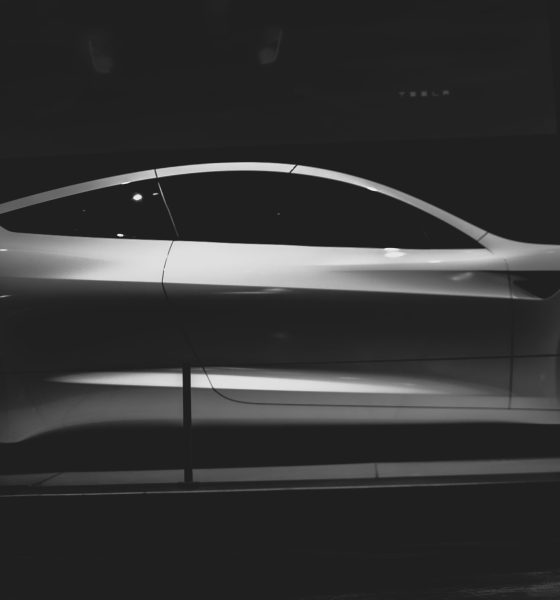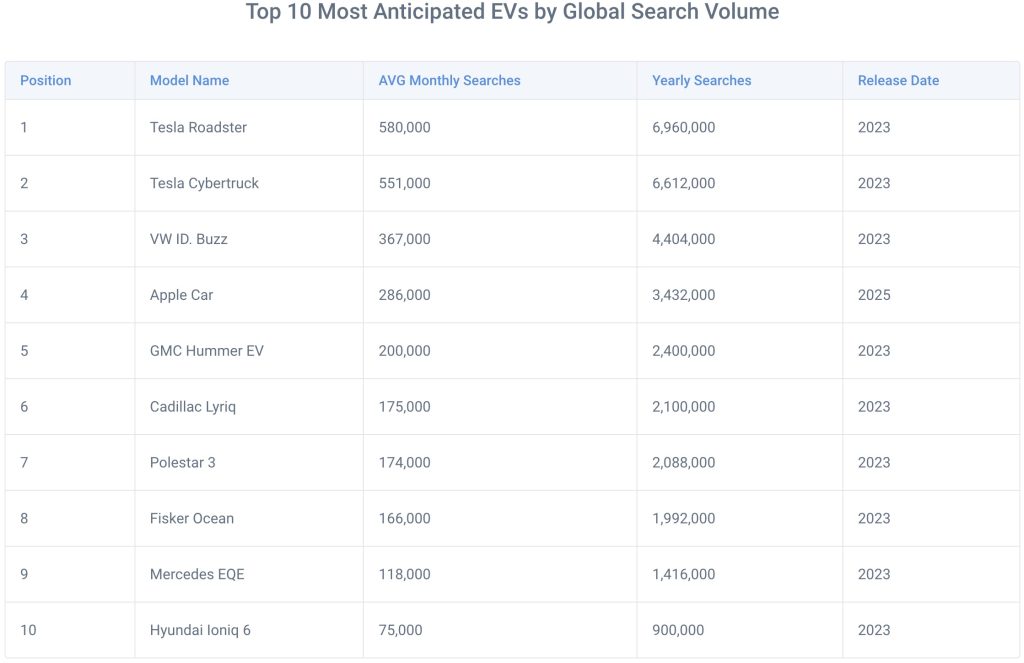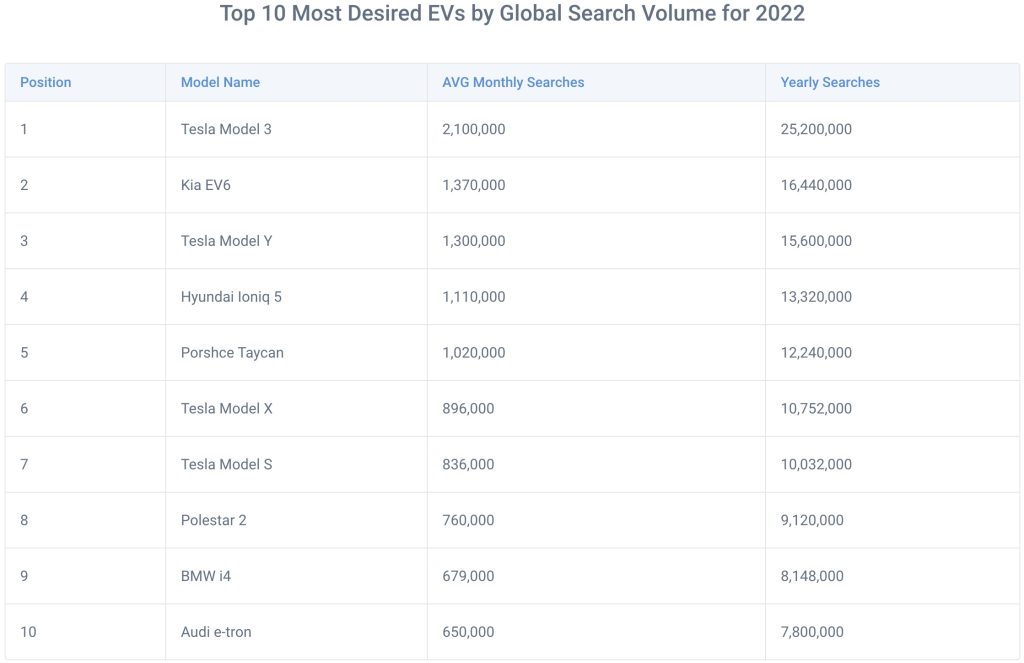

News
Tesla Roadster, Cybertruck top list of most anticipated EVs in the world
A study from Lease Fetcher, a UK-based vehicle leasing comparison platform, has determined that among the EVs that are yet to be released and those that are already available in the market, Tesla’s cars are among the most desired. After studying the search volume for electric cars across 172 countries, the UK-based firm found that the Tesla Roadster is the most anticipated EV model worldwide.
The firm’s study found that overall, the Tesla Roadster has been searched a whopping 6,960,000 times in 2022. That’s an average of 580,000 times per month. This is quite impressive because the new Roadster is not even out yet, and it’s been years since its initial unveiling. While the Roadster would likely be a vehicle that is not mass manufactured anywhere close to the volumes of the Model 3 and Model Y, it is nonetheless an EV that captures the imagination.
Following the Tesla Roadster is the electric vehicle maker’s other upcoming vehicle, the Cybertruck. The study found that the Cybetruck was the second most anticipated electric car model on a global scale, with the vehicle being searched for 6,612,000 times. Just like the next-generation Roadster, the interest surrounding the Cybertruck is impressive, considering the vehicle’s delayed deliveries and production.

Interestingly, the EVs that followed the Tesla Roadster and the Cybertruck was a rather eclectic mix of electric cars. Behind the Cybertruck, for example, was the Volkswagen ID. Buzz, which saw 4,404,000 global searches; the very-much-still-a-rumor Apple Car, which saw 3,432,000 global searches, and the 2023 GMC Hummer EV, which saw 2,400,000 searches worldwide.
This does not mean to say that Tesla’s existing lineup is not seeing a lot of interest. As noted by the car leasing company’s study, the Tesla Model 3 sedan is actually still the hottest EV on the internet, seeing an incredible 25,200,000 searches globally. That’s an average of 2,100,000 per month. Following the Model 3 is the Kia EV6, which saw 16,440,000 yearly searches, the Tesla Model Y crossover, which saw 15,600,000 annual searches, the Hyundai Ioniq 5, which saw 13,320,000 searches, and the Porsche Taycan, which saw 12,240,000 global searches.

The Tesla Model S and Model X are still part of the list of the world’s most desired EVs by global search volume. The Model X, for example, is in sixth place with 10,752,000 global searches. The Model S is right behind the Model X, with 10,032,000 global searches. This suggests that Tesla’s entire electric vehicle catalog — including its more expensive models — is ranked among the world’s most desirable EVs.
Lease Fetcher summarized its thoughts about Tesla’s results in the following statement.
“Tesla has such a domineering presence in the electric car industry that it’s no surprise that their models are amongst the most popular current models, and the most anticipated. For many, Tesla is synonymous with electric cars. In terms of models available in 2022, the Tesla Model 3 has been a massive hit with EV buyers – it’s a powerful, environmentally-friendly model with an attractive body. It has been a welcome change for many EV buyers who were not drawn in by some of the quirkier EV designs by other manufacturers,” the firm noted.
The full study from Lease Fetcher can be viewed here.
Don’t hesitate to contact us with news tips. Just send a message to simon@teslarati.com to give us a heads up.

Elon Musk
Elon Musk’s Grok records lowest hallucination rate in AI reliability study
Grok achieved an 8% hallucination rate, 4.5 customer rating, 3.5 consistency, and 0.07% downtime, resulting in an overall risk score of just 6.

A December 2025 study by casino games aggregator Relum has identified Elon Musk’s Grok as one of the most reliable AI chatbots for workplace use, boasting the lowest hallucination rate at just 8% among the 10 major models tested.
In comparison, market leader ChatGPT registered one of the highest hallucination rates at 35%, just behind Google’s Gemini, which registered a high hallucination rate of 38%. The findings highlight Grok’s factual prowess despite the AI model’s lower market visibility.
Grok tops hallucination metric
The research evaluated chatbots on hallucination rate, customer ratings, response consistency, and downtime rate. The chatbots were then assigned a reliability risk score from 0 to 99, with higher scores indicating bigger problems.
Grok achieved an 8% hallucination rate, 4.5 customer rating, 3.5 consistency, and 0.07% downtime, resulting in an overall risk score of just 6. DeepSeek followed closely with 14% hallucinations and zero downtime for a stellar risk score of 4. ChatGPT’s high hallucination and downtime rates gave it the top risk score of 99, followed by Claude and Meta AI, which earned reliability risk scores of 75 and 70, respectively.

Why low hallucinations matter
Relum Chief Product Officer Razvan-Lucian Haiduc shared his thoughts about the study’s findings. “About 65% of US companies now use AI chatbots in their daily work, and nearly 45% of employees admit they’ve shared sensitive company information with these tools. These numbers show well how important chatbots have become in everyday work.
“Dependence on AI tools will likely increase even more, so companies should choose their chatbots based on how reliable and fit they are for their specific business needs. A chatbot that everyone uses isn’t necessarily the one that works best for your industry or gives accurate answers for your tasks.”
In a way, the study reveals a notable gap between AI chatbots’ popularity and performance, with Grok’s low hallucination rate positioning it as a strong choice for accuracy-critical applications. This was despite the fact that Grok is not used as much by users, at least compared to more mainstream AI applications such as ChatGPT.
News
Tesla (TSLA) receives “Buy” rating and $551 PT from Canaccord Genuity
He also maintained a “Buy” rating for TSLA stock over the company’s improving long-term outlook, which is driven by autonomy and robotics.

Canaccord Genuity analyst George Gianarikas raised his Tesla (NASDAQ:TSLA) price target from $482 to $551. He also maintained a “Buy” rating for TSLA stock over the company’s improving long-term outlook, which is driven by autonomy and robotics.
The analyst’s updated note
Gianarikas lowered his 4Q25 delivery estimates but pointed to several positive factors in the Tesla story. He noted that EV adoption in emerging markets is gaining pace, and progress in FSD and the Robotaxi rollout in 2026 represent major upside drivers. Further progress in the Optimus program next year could also add more momentum for the electric vehicle maker.
“Overall, yes, 4Q25 delivery expectations are being revised lower. However, the reset in the US EV market is laying the groundwork for a more durable and attractive long-term demand environment.
“At the same time, EV penetration in emerging markets is accelerating, reinforcing Tesla’s potential multi‑year growth runway beyond the US. Global progress in FSD and the anticipated rollout of a larger robotaxi fleet in 2026 are increasingly important components of the Tesla equity story and could provide sentiment tailwinds,” the analyst wrote.
Tesla’s busy 2026
The upcoming year would be a busy one for Tesla, considering the company’s plans and targets. The autonomous two-seat Cybercab has been confirmed to start production sometime in Q2 2026, as per Elon Musk during the 2025 Annual Shareholder Meeting.
Apart from this, Tesla is also expected to unveil the next-generation Roadster on April 1, 2026. Tesla is also expected to start high-volume production of the Tesla Semi in Nevada next year.
Apart from vehicle launches, Tesla has expressed its intentions to significantly ramp the rollout of FSD to several regions worldwide, such as Europe. Plans are also underway to launch more Robotaxi networks in several more key areas across the United States.
News
Waymo sues Santa Monica over order to halt overnight charging sessions
In its complaint, Waymo argued that its self-driving cars’ operations do not constitute a public nuisance, and compliance with the city’s order would cause the company irreparable harm.

Waymo has filed a lawsuit against the City of Santa Monica in Los Angeles County Superior Court, seeking to block an order that requires the company to cease overnight charging at two facilities.
In its complaint, Waymo argued that its self-driving cars’ operations do not constitute a public nuisance, and compliance with the city’s order would cause the company irreparable harm.
Nuisance claims
As noted in a report from the Los Angeles Times, Waymo’s two charging sites at Euclid Street and Broadway have operated for about a year, supporting the company’s growing fleet with round-the-clock activity. Unfortunately, this has also resulted in residents in the area reportedly being unable to sleep due to incessant beeping from self-driving taxis that are moving in and out of the charging stations around the clock.
Frustrated residents have protested against the Waymos by blocking the vehicles’ paths, placing cones, and “stacking” cars to create backups. This has also resulted in multiple calls to the police.
Last month, the city issued an order to Waymo and its charging partner, Voltera, to cease overnight operations at the charging locations, stating that the self-driving vehicles’ activities at night were a public nuisance. A December 15 meeting yielded no agreement on mitigations like software rerouting. Waymo proposed changes, but the city reportedly insisted that nothing would satisfy the irate residents.
“We are disappointed that the City has chosen an adversarial path over a collaborative one. The City’s position has been to insist that no actions taken or proposed by Waymo would satisfy the complaining neighbors and therefore must be deemed insufficient,” a Waymo spokesperson stated.
Waymo pushes back
In its legal complaint, Waymo stated that its “activities at the Broadway Facilities do not constitute a public nuisance.” The company also noted that it “faces imminent and irreparable harm to its operations, employees, and customers” from the city’s order. The suit also stated that the city was fully aware that the Voltera charging sites would be operating around the clock to support Waymo’s self-driving taxis.
The company highlighted over one million trips in Santa Monica since launch, with more than 50,000 rides starting or ending there in November alone. Waymo also criticized the city for adopting a contentious strategy against businesses.
“The City of Santa Monica’s recent actions are inconsistent with its stated goal of attracting investment. At a time when the City faces a serious fiscal crisis, officials are choosing to obstruct properly permitted investment rather than fostering a ‘ready for business’ environment,” Waymo stated.








